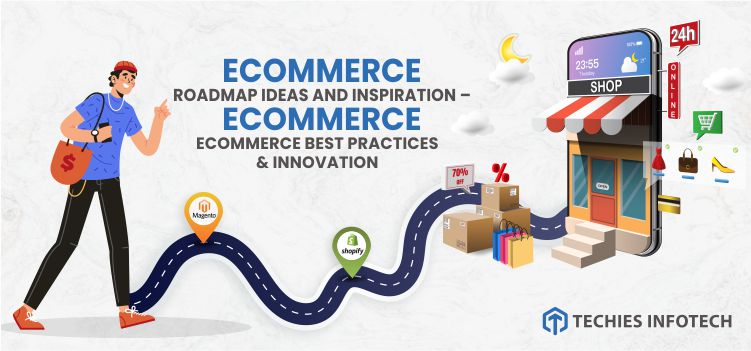In the fastest-growing eCommerce business, an eCommerce roadmap is vital to breed success.
Did you know that in 2021, eCommerce sales worldwide were $4.921 trillion? Also, the eCommerce market is likely to continue growing in the foreseeable future, with the projected worldwide sales for 2022 being 6.54 billion dollars.
So to ensure that your company continues to get a piece of the ever-expanding eCommerce pie, you must create an eCommerce website roadmap. It is a foundation to stand tall among 20 million global eCommerce websites.
But what exactly is an eCommerce roadmap, and how does it help in eCommerce website development?
An eCommerce roadmap is defined as a visual communication tool for an eCommerce organization. This roadmap aligns various marketing, design and development initiatives involved in growing your eCommerce business.
Creating an effective roadmap allows your company to clearly understand new potentials in terms of scope, size, priority and targeted customers.
How to build a successful eCommerce roadmap?
What’s more complex than building an eCommerce website roadmap? Well, it’s deciding to go for your website’s roadmap.
So if you have already decided to build a successful eCommerce roadmap but you don’t have it yet, the good news is you can do it now.
For an eCommerce website development, you have to scratch your head, strategize day in and out to keep up with your competitor’s pace. After that, you have to build a successful eCommerce roadmap that will center around your website goals and customers.
Additionally, you have to follow a series of steps to build your eCommerce strategy roadmap so that you will deliver the sort of offerings that people will scoop up.
Read on to know more about how you can build a successful eCommerce website roadmap to take up on your business rivalries:
Components of a good eCommerce roadmap
Governance
The success of any roadmap hinges on the proper implementation of governance with the right level of support.
Corporate governance should be established early to provide a mechanism to determine priorities, make decisions and solve the issues. Additionally, it requires full team support throughout the life of the roadmap.
Risk management
The risk management plan is a vehicle to assess the risk that may derail your eCommerce roadmap. Risk should be thought of as the potential threats and opportunities that need to be managed for the success of your roadmap.
Change management
No roadmap is complete without considering the importance of change management. Change management focuses on the people needed to understand and commit to the changes needed to implement the roadmap.
Successful change management aims at maximizing the success of your business at any cost.
Organization
As your company moves to implement a new strategy, change to your organization may occur. This component of the eCommerce roadmap aims at adding new responsibilities for existing roles to the creation of a new organization.
Metrics
A metrics-driven approach is absolutely essential to a successful roadmap.
Metrics should be tied back to your strategic goals and business results. When creating a successful roadmap, you can use these metrics. However, avoid making too many metrics. Instead, start with a few metrics and create a roadmap based on them.
Steps to create an eCommerce roadmap
Step one: Gather insight on your target customers
The success of an eCommerce roadmap lies in your target customers? But how well do you know your target customers?
Most eCommerce platforms have a general idea of their customers’ demographic. However, they often make the mistake of stopping there.
Hence, for customers to resonate with your brand, you should consider various aspects:
- What challenges are my customers facing?
- Will they buy my product?
- What motivates them to buy a product?
- How do they interact with my site?
- What content are they engaging with the most?
By answering these questions, you can get a clarity on who your ideal customers are and how you can meet their needs.
Step two: Assess where you are currently
The content of your roadmap is generally dependent on what stage your business is at.
If you are at an early stage, this is going to differ from a well-established business with a strong customer base. Therefore, it is for you to be realistic about where you are and where you want to go.
For businesses starting their eCommerce journey, they have to put thoughts into selling products, competitors, wider business ambitions and the brand’s journey. Therefore, forming a clear and concise business entity is the best way to start taking positive steps forward.
Step three: Future mapping
Once you have the foundation for your website, you can start to layout your plan for future growth and success. This step will forge a clear path to get from where you are to where you want to go.
For this, you need to:
- Evaluate your current website analytics and sales number.
- Measure the results of your marketing strategy and media plans.
- Identify your business objectives and outline the budget for the rest of the year
- Fix a reasonable time for doing all the activities
Step 4: Devise effective strategies
The success of any eCommerce roadmap is dependent on devising effective strategies. After doing all the framework, it’s time for you to create a cohesive media plan.
Use the information you have gathered to:
- Decide which media channels are best suited to your objective.
- Establish a content strategy to enhance your customer engagement
- Define an appropriate budget based on your business goals
- Set metrics to measure results so that you will know what’s working and what’s isn’t.
Devising a strategy is not enough to bring long-term gains for your business. Big e-commerce giants like Amazon, Alibaba always stay proactive in the ever-changing digital world. They keep on updating their eCommerce strategy roadmap.
Therefore, it makes sense to keep on updating your eCommerce strategy roadmap.
Keyways to update your eCommerce strategy roadmap
The trend of online shopping continues to grow, as more consumers are opting to skip the stand in line at the store. They prefer to make purchases from a socially acceptable distance via the web.
Therefore, we have outlined the various ways that you can adopt to update your eCommerce strategy roadmap to meet the new online eCommerce habits of consumers.
Use data analysis to target your audience
This may seem to you like a basic concept, but it must be added to your eCommerce strategy roadmap. With a new wave of consumers spending money online, data analysis would be of great help to see what they are buying.
By finding exactly who your customers are, you can look at the demographics including, how they shop and what products are selling well. This will help you make a plan around how to target your future audience.
Reframe your UX strategy with intelligent guided selling
In today’s digitally focussed world, it is crucial to recreating the in-store experience through your online website. With the strategy of intelligent guided selling, you can offer a personalized experience to every customer and guide them through your website to the appropriate product and services.
The mindset of consumer’s convenience over everything is guiding companies to revamp their UX strategy. That is why the concept of intelligent guided selling comes to force. Through this integrated platform, a shopper can find the perfect item based on his budget, needs and mindset.
This strategy works on the basis of asking for assistance in the store. IGS ensures that your customers easily find and configure the right products and services.
Use data effectively across all touchpoints
To delve a little deeper into your customer’s psychology, you can use your findings across all touchpoints for precision marketing and targeted selling.
For instance, you can segment your email market list into demographic, motivation, mindset or shopping frequency. This kind of data can give advice regarding social media marketing, which platforms to use and the type of content to share.
Hence, this sort of data analysis can give an idea about what elements need to be added to your eCommerce roadmap strategy.
Develop a strong loyalty program
Having loyal customers is a dream for every eCommerce store!
An undeniable loyalty program is essential for the success of your eCommerce roadmap. When you reward customers for shopping on your online store, you invite them with the motive to keep coming back. These rewards can take the form of freebies, discounts, coupons or discounts.
Also, increasing your customer base means achieving long-term stability for your eCommerce store.
eCommerce roadmap ideas and inspiration
The more you know, the more you grow. This statement makes sense when it comes to building a successful eCommerce website roadmap.
Therefore, for your help, we have compiled some of the best ecommerce roadmap examples of eCommerce best practices and innovations for your inspiration. These examples range from UX and usability to examples of functional excellence, from retailers and brands of all shapes and sizes.
Best examples of eCommerce website development roadmap:
Apple’s UX design: Apple is an obvious example of a UX strategy done right. A company that is putting design and site design at its heart. Apple is known to offer a 360 view option on its products.
Unlike other sites, you don’t need to drag the image around. Moreover, they use parallax scrolling to make the images dynamic and eliminate all the exit points so that you will get immersed in the world of Apple.
Everlane product cards and curated PLP’s: Everlane’s PLP’s are among the strongest templates ever designed.
The product cards, specifically how the sizing and color options work, are very strong. Additionally, its curated groups of products (with filtering) are also very modern and well-executed.
Asos knock-out value proposition: Asos UX design is a brilliant example of a successful roadmap. Great images, fast click, simple explainer and obvious call-to-action direct you to the men and women section.
One of their standout features is the video catwalk. It helps visitors to actually see what an outfit looks like. There is also an explanation video by the stylist. This gives more convenience to the customers visiting their website.
Nike’s mobile usability: Mobile usability is an under-resourced area of eCommerce roadmaps. Nike is an excellent example of a highly usable and accessible with well-optimized call-to-action, super-readable text and multiple-optimized navigation.
Everlane’s contextual reviews: Everlane’s implementation of product reviews is a brilliant example of its site quality. Its users are able to filter for reviews on their site, which provides great context around sizing and fit.
Mansur Gavriel welcome popup: Mansur Gavriel is an excellent example of Shopify plus store. The site features a clean welcome popup that provides detail on local servicing. It helps users to purchase and end their purchase journey in a smooth way.
Therefore, recognizing the importance of an eCommerce roadmap, our company creates on-top digital roadmaps for the clients. We have got the chance to collaborate with some of the top eCommerce giants to build successful eCommerce websites for them.
Examples of things we have suggested to our clients recently:
Adventure HQ: Accelerating customer engagement
For Adventure HQ, we have developed a full-service Shopify development platform. We worked towards enhancing their overall website architecture in order to generate more traffic.
Additionally, we revamped their website functionality to bring more customer engagement. Adventure HQ’S eCommerce website is an amazing example of a successful eCommerce website roadmap.
You can also read the case study of Adventure HQ to know more about its successful eCommerce roadmap strategy.
Forever 21 : Engaging UI/UX strategies
To unleash endless opportunities, we offered an engaging UI/UX approach to holistic SEO strategies for Forever 21’s website.
We developed a feature-rich online platform backed by Shopify for the Forever 21 store. Also, we created a holistic roadmap to align the SEO strategies with their current brand values.
To know more about the successful eCommerce website roadmap of Forever 21, you can read their case study on our website.
Join hands with Techies Infotech
At Techies Infotech, we offer the best-of-breed digital solutions to our clients. We stand tall among leading ecommerce website development company. Our objective is to work seamlessly to make your project the best it can possibly be.
Contact us and get ready to dominate the digital world!












